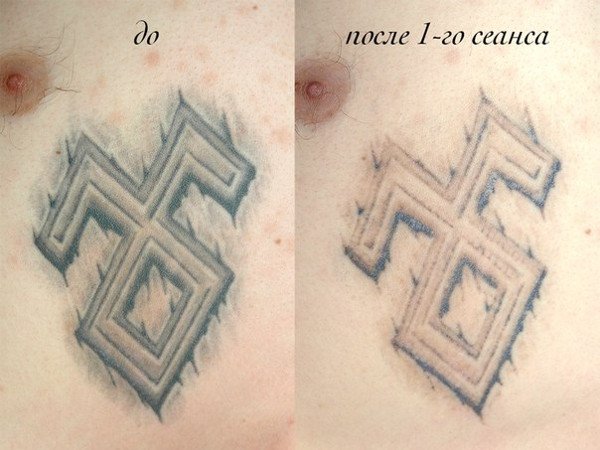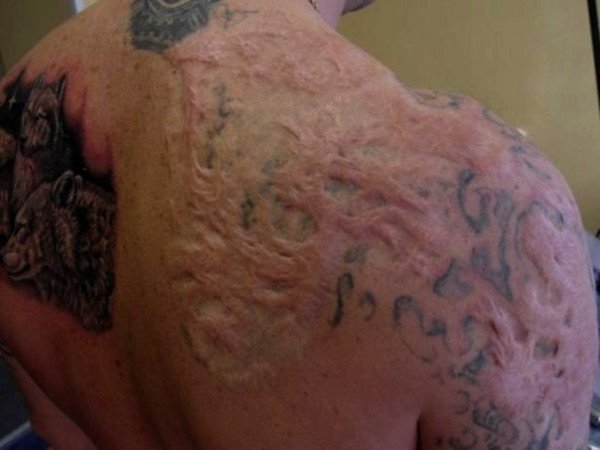Laser tattoo removal is possible: everything about indications and contraindications
 Tattoos are no longer considered permanent and irreversible marks on the skin.
Tattoos are no longer considered permanent and irreversible marks on the skin.
Dermatological surgeons can safely and effectively use various methods to successfully remove unwanted tattoos.
There are several options for tattoo removal, the laser among which ranks first. Other methods include dermabrasion and surgical cutting of tattooed areas.
Before removing the tattoo with a laser, the doctor should assess the size, colors and its location, as well as a number of other factors.
Why remove the tattoo?
Many social, cultural, and physical changes in life affect the decision to remove tattoos:
- Allergic reactions.
- Misunderstanding from a partner.
- Search or get a new job.
- Replacing one tattoo with another.
Professionally made tattoos tend to penetrate the deeper layers of the skin at uniform levels. This uniformity allows dermatologist surgeons to use methods that remove wider areas of inked skin at the same depth.
- Professional tattoos made with some newer inks and pastel colors can be difficult to remove completely.
- Removing homemade tattoos, often made with an uneven hand, is complicated.
- The dark blue and black ink colors are especially difficult to remove.
- Newer tattoos often tend to be more difficult to remove than tattoos that are over 1 year old.
- Complete removal of the tattoo is not always possible.
- Perhaps some discoloration of the skin and the surface of the fabric.
- Tattoo removal is almost always performed on an outpatient basis.
To remove a tattoo with a laser, you must:
- Get the right doctor. Choose someone qualified to perform tattoo removal procedures.
- Discuss with your doctor the reasons why you want to remove your tattoo, what are your expectations.
- Learn about costs. Tattoo removal is considered an aesthetic or cosmetic procedure, free medical insurance is not covered.
- Take care of yourself. All procedures before removing the tattoo and after follow the recommendations, if you have any questions, consult a specialist.
Contraindications for tattoo removal:
- Think about tattoo removal if there are certain autoimmune systemic diseases, problems with pigmentation, active acne, warts , unstable diabetes.
- Removing the tattoo yourself, which can lead to infections.
- Perform the procedure in unsanitary conditions.
- Infection in the body.
The main rules of laser tattoo removal
 In the event that you have already decided that you need a tattoo removal procedure, we recommend that you familiarize yourself with the rules below.
In the event that you have already decided that you need a tattoo removal procedure, we recommend that you familiarize yourself with the rules below.
This will allow you to be more prepared both for the removal process itself and for its consequences, once again weigh the pros and cons, and also correctly select the type of laser.
Poor removal of a tattoo with a laser can lead to sad consequences in the form of scars and impaired pigmentation, which looks much worse than the tattoo itself.
- Decide on what you expect from the procedure.
There is no guarantee that the tattoo will retire completely. Mandatory consultation is required before laser tattoo removal with a laser therapy specialist. Some tattoos only partially disappear after several sessions of removal and can leave a barely noticeable image, as well as scars. Thus, it is necessary to answer the question what is better - a barely noticeable image of a tattoo or only a part of it, corrected by the tattoo master. - Unable to remove the tattoo in one session.
May require repeated laser exposure to the tattooed area. Be careful if a tattoo removal specialist prescribes6-10 sessions for complete removal. In addition, the intervals between sessions are also a key factor, the average time between sessions is 4-6 weeks. In some cases, between sessions of laser tattoo removal is scheduled at 8 weeks. - The location of the tattoo.
In most cases, location really matters. Laser tattoo removal is usually slower in the areas at the bottom of the arm or leg, as they are located far from the heart. - Learn about the different types of lasers.
There is no universal laser that can remove all the colors of a tattoo. A certain color corresponds to a certain length of the laser beam. Sometimes the removal of some pigments may require lasers with different wavelengths. - What to expect after laser tattoo removal.
There are several side effects after removing the tattoo, among them are blisters, tumors, tattoo rises, bleeding, redness and / or temporary blackout. Typically, these manifestations subside within1-2 weeks. - Potential side effects.
The most common side effect of laser tattoo removal is hyper-darkening or the appearance of keloid scars, which disappear after5-12 months. Infection, burns and structural changes in the skin disappear within 4 weeks. - Darkening of pigments.
Some inks used in cosmetic tattoos, including colors containing white inks, may darken (oxidize) immediately after treatment due to the presence of titanium dioxide. This is corrected in subsequent sessions. - The appearance of hyperpigmentation in people with dark skin.
People with darker skin can also remove the tattoo with a laser, however there is a higher risk of hyperpigmentation, because the laser can remove pigment from the skin along with pigment from the tattoo. Your technician should take care and test on a small area of skin to minimize any risk.
ZZZ 07/26/2016 7:02:03 PM
Very valuable advice, read on time, thanks to the author. I almost made a mistake, I wanted to go to a not exactly professional master. I was just about to remove the tattoo, which I did 3 years ago. Now I cannot wear open clothes because of her - they won't understand me at work. Given the recommendations of the author, I will look for a specialist in a good clinic.